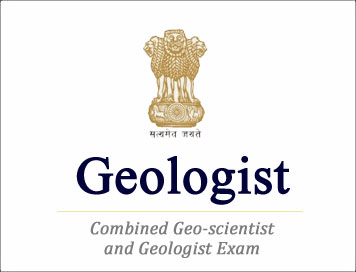(HOT) UPSC Current Affairs 2025 PDF
NEW! The Gist (NOV-2025) | E-BOOKS
UPSC Geo-Scientist and Geologist Exam Papers 2018 : Geology Paper- III

(Download) UPSC: Geologist Examination Papers-2018
Exam Name : UPSC Geo-Scientist and Geologist Exam
Subject : UPSC Geo-Scientist and Geologist Exam Papers 2018 : Geology Paper- III
Year : 2018
GEOLOGY PAPER—III
Time Allowed : Three Hours
Maximum Marks : 200
QUESTION PAPER SPECIFIC INSTRUCTIONS
Please read each of the following instructions carefully before attempting questions.
There are ELEVEN questions divided under SIX Sections.
Candidate has to attempt SIX questions in all.
The ONLY question in Section A is compulsory.
Out of the remaining TEN questions, the candidate has to attempt FIVE, choosing ONE from each of the other Sections B, C, D, E and F.
The number of marks carried by a question/part is indicated against it.
Symbols, abbreviations and notations have their usual standard meanings.
Neat sketches are to be drawn to illustrate answers, wherever required. Wherever required, graphs/tables are to be drawn on the QCA Booklet itself.
Attempts of questions shall be counted in sequential order. Unless struck off, attempt of a question shall be counted even if attempted partly.
Any page or portion of the page left blank in the QCA Booklet must be clearly struck off.
Answers must be written in ENGLISH only.
SECTION-A
1. Write on/Answer each of the following in short with sketches, wherever necessary :
(a) Reserves and occurrence of gold deposits in India
(b) Mineralogy and classification of chromite deposits in India
(c) Common rock types found in skarn deposits and factors which control skarn
mineralization
(d) Induced potential methods of geophysical exploration
(e) Reserves, probable resource and hypothetical resources for mineral
commodities
(f) Geobotanical indicators of ore deposits
(g) Describe briefly about structural oil traps.
(h) Stratigraphic status of Neyveli lignite deposits
(i) Remedial measures of landslides
(j) Compressive strength of rocks
SECTION-B
Attempt any one question
2. (a) Describe in detail about the mineralogy, modes of occurrence,
origin and distribution of nickel deposits in India.
(b) Discuss in detail about UNFC's classification of mineral resources
and reserves.
3. (a) Give an account of the marine mineral resources of
India.
(b) Describe the uses, occurrence and distribution of gypsum deposits of
India.
(c) Discuss in brief about strategic and critical minerals.
SECTION-C
Attempt any one question
4. (a) Describe the association of different magma types with ore
deposits and explain the role of geochemical behaviour of elements in ore
deposit formation.
(b) Name two mineral commodities for which gravity method of geophysical
exploration may be employed. Also discuss the principle and corrections of
gravity survey.
5. (a) Discuss the role of fluids in mineralization in magmatic
systems. What controls the solubility of water in silicate melts?
(b) What are kimberlites and from where these rocks are reported in
India? Mention the relationship between kimberlites and formation of diamonds.
(c) Describe metallogenesis through geological time. Illustrate your
answer with one major ore deposit of India.
SECTION-D
Attempt any one question
6. (a) Describe the main types of core drilling techniques. Also write
how planning for a core drilling of a sub-horizontal and a steeply dipping
deposit will be undertaken.
(b) What do you understand by coefficient of aqueous migration? Write the
factors which control the strength of a geochemical anomaly. Describe Hawkes
model relating the size of mineralization with the strength of geochemical
anomaly.
7. (a) Describe included and excluded area methods of ore reserve
estimation for an irregular grid sampled deposit.
(b) What are the different types of sampling errors? Describe Gy's theory
for minimization of these errors.
(c) Estimate ore reserves of a Zn deposit by cross-section method with
the following data. Assume a dilution factor of 10%. Use the rule of influence
for defining the strike length. Calculate the average grade of ore also :
| Section | Section area (sq. m) | Grade (Percentage) | Bulk Density (gm/cm3) |
| A | 1500 | 6.7 | 2.8 |
| B | 1800 | 4.3 | 2.9 |
| C | 2200 | 5.1 | 2.9 |
SECTION—E
Attempt any one question
8. (a) Describe in detail the transformation of organic matter into
oil and gas. What is the role of temperature in this transformation?
(b) Discuss coal characterization in terms of lithotypes and macerals.
Also describe the coal classification based on chemistry.
9. (a) What is oil shale? Briefly explain the problem of recovery of
oil from oil shale.
(b) Enumerate the types of environment for the formation of radioactive
mineral deposits.
(c) Describe the radioactive methods in petroleum exploration.
SECTION-F
Attempt any one question
10. (a) Give an account of the geological investigations at bridge
sites for the stability of a bridge.
(b) Explain the various groundwater problems in connection with the
construction of dams and tunnels.
11. (a) Give an account of the types of forces to be accounted for in
the construction of dams in seismically active areas.
(b) Explain the excavating cycle of a tunnel during construction in a
hard rock terrain.
(c) Describe the different types of coastal protection structures.
Click Here to Download PDF
<< Go Back To Main Page
Courtesy: UPSC

